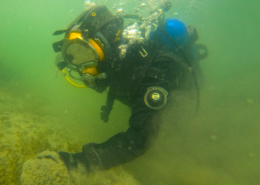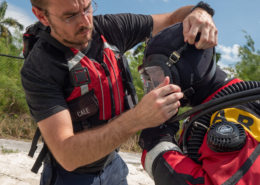Preparing Your Department for a Surface Ice Rescue
By: Robert Shields
With the winter season now upon us, ask yourself “are we ready for an ice rescue in our response area?”. If you cannot answer with a resounding YES, then here are some considerations to help prepare your department.
Training
First and foremost, get trained. Search for training agencies and companies that offer surface ice rescue courses. Ensure that these agencies/companies provide training that meets or exceeds NFPA 1670 and 1006. Getting certified by a reputable training agency/company is a much safer option than just trying to figure it on your own.
Standard Operating Guidelines
Once your department has the training, the next step should be to develop standard operating guidelines. An online search for Ice Rescue SOG’s can provide ideas on how to create your own. Using the information provided in the training program can also aid in creating the guideline. SOG’s will help ensure that everyone is on the same page when it comes to managing a surface ice rescue incident.
Equipment
After developing an SOG, check to see if the proper equipment is available. Ice Rescue Suits should be mandatory for all technician level rescuers who will be assigned as the primary or backup rescuers. Using a scuba or swiftwater Drysuit is an option, but these have no inherent buoyancy, so a PFD is needed along with a harness to attach the tether line. Along with exposure protection, responders working on the ice need to be equipped with ice picks for self-rescue and/or stabilization on the ice shelf during a rescue. Along with the suits, water rescue style helmets should also be provided. Other equipment for rescuers could include a knife and whistle along with ice cleats and fins. For shore-based responders, a PFD and water rescue style helmet needs to be worn if working within ten feet of the ice or water’s edge. Turnout gear should not be worn. Even though it provides thermal protection, it will absorb water if the wearer falls in, resulting in a submersion incident.
An equipment consideration for rescuers is using a mask and snorkel. In the event the victim has submerged, the rescuer can search from the surface in the point last seen area. As long as the bottom has not been stirred up, rescuers should have descent visibility due to the cold-water limiting algae growth thereby decreasing turbidity in the water. If the victim can be located this way, a pike pole or other long object can be used to rescue the victim
The next piece of equipment is a rope or tether line. It should be a water rescue style rope constructed of polypropylene for its floating characteristics and a minimum of 7/16” diameter. For all rescues, the tether line needs to be attached to the front of the primary rescuer. This line not only acts as the safety line for the primary rescuer but can be used as attachment point for equipment to aid in the rescue.
If a department has a piece of specialized equipment such as a board or sled, they need to receive training from a qualified trainer or manufacturer representative and be proficient in its use. Ice rescuers should also be familiar using equipment which is available in all departments such as webbing slings, back boards, ladders, and life rings.
Training, developing guidelines, and acquiring the proper equipment will not only assist departments in the successful rescue a victim through the ice, but make the rescue effort as safe as possible.




 Y. ZIN
Y. ZIN




Ответить
Хотите присоединиться к обсуждению?Не стесняйтесь вносить свой вклад!